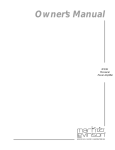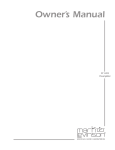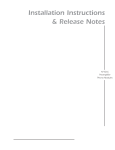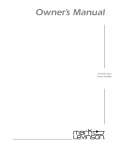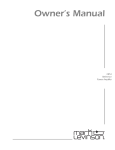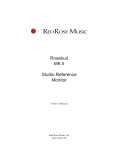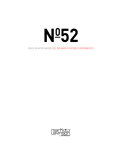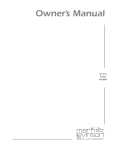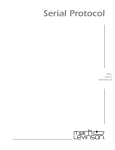Download Mark Levinson N 320S Specifications
Transcript
Installation Instructions & Release Notes Nº 320S Preamplifier Phono Modules Safety Summary The following general safety precautions must be observed during all phases of operation, service, and repair of the component. Failure to comply with these precautions or with specific warnings elsewhere in this document violates manufacturer safety standards and intended use of the component. Mark Levinson assumes no liability for failure to comply with these requirements. Ground the Instrument To minimize shock hazard, the component chassis and cabinet must be connected to an electrical ground. The component is equipped with a three-conductor AC power cord. The power cord must be connected to either an approved three-contact electrical outlet or a three-contact-to-two-contact adapter with the grounding wire (green) firmly connected to an electrical ground (safety ground) at the electrical outlet. The power jack and mating plug of the power cord meet IEC (International Electro-technical Commission) safety standards. Do Not Operate in an Explosive Atmosphere Do not operate the component in the presence of flammable gasses or fumes. Operation of any electrical component in such an environment creates a definite safety hazard. Keep Away from Live Circuits Operating personnel must not remove component covers. Qualified maintenance personnel must make component replacements and internal adjustments. Do not replace components when the power cord is connected. Under certain conditions, dangerous voltages may be present even when the power cord is disconnected. To avoid personal injuries, always disconnect the power cord and discharge circuits before handling them. Do Not Service or Adjust Alone Do not attempt internal service or adjustment unless another person capable of rendering first-aid resuscitation is present. Do Not Substitute Parts or Modify Component Because of the danger of introducing additional hazards, do not install substitute parts or perform any unauthorized modifications to this component. Dangerous Procedure Warnings Warnings such as the example shown below accompany potentially dangerous procedures throughout this document. Instructions contained in these warnings must be followed. WARNING • DANGEROUS VOLTAGES CAPABLE OF CAUSING DEATH ARE PRESENT IN THIS COMPONENT. USE EXTREME CAUTION WHEN HANDLING, TESTING, OR ADJUSTING. • DISCONNECT ALL POWER TO THE COMPONENT PRIOR TO INSTALLING THE PHONO MODULES. ESD (Electrostatic Discharge) Precautions CAUTION The following practices minimize possible damage to circuit board assemblies resulting from electrostatic discharge or improper insertion: • Keep circuit board assemblies in their original containers until ready for use. • Avoid having plastic, vinyl, or Styrofoam in the work area. • Wear an anti-static wrist strap. • Discharge personal static before handling circuit board assemblies. • Remove and insert circuit board assemblies with care. • When removing circuit board assemblies, handle only by non-conductive surfaces. Never touch open-edge connectors except at a static-free workstation*. • Minimize handling of circuit board assemblies. • Do not slide circuit board assemblies over any surface. • Insert circuit board assemblies with the proper orientation. • Use anti-static containers for handling and transporting circuit board assemblies. * To make a static-free workstation, wash a plastic-laminated workbench with a solution of Lux liquid detergent. Allow to dry without rinsing. 3 Oak Park Bedford, MA 01730-1413 USA Telephone: 781-280-0300 Fax: 781-280-0490 www.marklevinson.com Customer Support Telephone: 781-280-0300 Sales Fax: 781-280-0495 Service Fax: 781-280-0499 Product Shipments 16 Progress Road Billerica, MA 01821-5730 USA Part No. 070-630494 | Rev 0 | 02/04 “Mark Levinson” and the Mark Levinson logo are registered trademarks of Harman International Industries. U.S. patent numbers and other worldwide patents issued and pending. “Madrigal Audio Laboratories” and the Madrigal Audio Laboratories logo are registered trademarks of Harman International Industries. U.S. patent numbers and other worldwide patents issued and pending. ©2004 Harman Specialty Group. All rights reserved. This document should not be construed as a commitment on the part of Harman Specialty Group. The information it contains is subject to change without notice. Harman Specialty Group assumes no responsibility for errors that may appear within this document. 3 Installation Instructions & Release Notes Mark Levinson Table of Contents Documentation Conventions . . . . . . . . . . . . . . . . . . . . . . . . .5 Special Design Features . . . . . . . . . . . . . . . . . . . . . . . . . . . . .6 Unpacking . . . . . . . . . . . . . . . . . . . . . . . . . . . . . . . . . . . . . .7 Configuring & Installing the Phono Modules . . . . . . . . . . . . . .7 Configuration Instructions • Installation Instructions Making Phono Input Connections . . . . . . . . . . . . . . . . . . . .14 Phono Input Settings . . . . . . . . . . . . . . . . . . . . . . . . . . . . .15 Name • Bal Phono Module Specifications . . . . . . . . . . . . . . . . . . . . . . . .20 4 Notes . . . . . . . . . . . . . . . . . . . . . . . . . . . . . . . . . . . . . . . . .21 Nº 320S Preamplifier Phono Modules Installation Instructions & Release Notes Documentation Conventions This document contains hardware installation instructions and software release notes for the Nº 320S Preamplifier Phono Modules. Refer to the Nº 320S Preamplifier Owner’s Manual for general safety, installation, and operation instructions. Appears on the component to indicate the presence of uninsulated, dangerous voltages inside the enclosure – voltages that may be sufficient to constitute a risk of shock. Appears on the component to indicate important operation and maintenance instructions included in the accompanying documentation. Appears on the component to indicate compliance of with the EMC (Electromagnetic Compatibility) and LVD (Low-voltage Directive) standards of the European Community. Calls attention to an ESD (electrostatic discharge) procedure, practice, condition, or the like that, if not correctly performed or adhered to, could result in damage to circuit board assemblies. WARNING Calls attention to a procedure, practice, condition, or the like that, if not correctly performed or adhered to, could result in personal injuries or death. CAUTION Calls attention to a procedure, practice, condition, or the like that, if not correctly performed or adhered to, could result in damage or destruction to part or all of the component. Note Calls attention to information that is essential to highlight. 5 Installation Instructions & Release Notes Mark Levinson Special Design Features • Seamless Integration When the phono modules are installed, the stereo input connector labeled 7 becomes the phono input connector, accepting input signals from most phono cartridges. As a result, the phono modules benefit from all the high-performance power supply and noise suppression features designed into the Nº 320S, allowing them to deliver exceptional sound quality. Each phono module relies on the same low-noise power supply as the main audio circuits in addition to its own local, lownoise, high-speed voltage regulators. • Flexible Configuration Multiple loading and input gain options make the phono modules compatible with most phono cartridges, including moving-coil, moving-magnet, high-output, and low-output designs. Three adjustable jumpers provide 200Ω or 47kΩ resistive loading; 0 or 10nF capacitive loading; and 40 or 60dB input gain. Convenient gold-plated, solder-less screw terminals accommodate custom loading. 6 • Balanced Design Available on a proprietary Mark Levinson-designed stereo RCA connector, the phono input provides the same common mode noise rejection benefits as a balanced XLR connector. The input gain stage produces a symmetrical pair of opposite polarity signals, based solely on voltage differences present at the input. Each balanced signal follows the same signal path, including identical RIAA equalization. • Instrumentation Amplifier Stage Gain is distributed over two stages, allowing ample bandwidth and open-loop gain for superior performance – even at the 60dB input gain required for moving-coil phono cartridges. Introduced with the Nº 38, the instrumentation amplifier stage resolves tiny electrical signals from potentially noisy environments. This method offers high common mode noise rejection without the limitations of transformer-based designs. • Precise RIAA Equalization A balanced pair of RIAA equalization circuits follows the input gain stages. These circuits include a filter constructed with 0.5% non-inductive metal-film resistors and 2.5% stacked-film capacitors as well as a subsonic filter below 10Hz for uncompromised RIAA curve accuracy. Nº 320S Preamplifier Phono Modules Installation Instructions & Release Notes Unpacking CAUTION EXPOSURE TO STATIC ELECTRICITY MAY DAMAGE OR DEGRADE THE PHONO MODULES. KEEP CIRCUIT BOARD ASSEMBLIES IN THEIR ESD PROTECTIVE BAGS UNLESS CONFIGURING OR INSTALLING. DO NOT REMOVE CIRCUIT BOARD ASSEMBLIES FROM THEIR ESD PROTECTIVE BAGS WITHOUT FOLLOWING ESD PRECAUTIONS (PAGE 3). When unpacking the phono modules: • Save all packing materials for possible future shipping needs. • Inspect the phono modules for signs of damage during shipment. If damage is discovered, contact an authorized Mark Levinson dealer for assistance making the appropriate claims. • Locate and remove all items from the packing carton. Contact an authorized Mark Levinson dealer if the packing carton does not include all of the items listed in the table below. Item Quantity Nº 320S Phono Modules 2 Anti-static wrist strap 1 1/8-inch hex-key 1 Flat-blade screwdriver 1 Configuring & Installing the Phono Modules The phono modules require special care and handling during configuration and installation to ensure optimal performance. Pay particular attention to precautions that appear in this section, as well as to the Safety Summary (page 2) and ESD Precautions (page 3). Damage caused during configuration or installation may void the manufacturer’s warranty and/or standard repair policies. 7 Installation Instructions & Release Notes Configuration Instructions Mark Levinson The phono modules must be optimized to work with the associated phono cartridge. Each phono module includes: • 1 adjustable resistive load jumper • 1 adjustable capacitive load jumper • 1 adjustable input gain jumper • 2 screw terminals that accommodate custom loads These features are identified in the illustration shown below. 1 2 3 RL =47K RL =200 C L =0nF C L=10nF G=40db G=60db JUMPER SETTINGS CLOSED OPEN 4 CUSTOM TERMINATION No.320S PHONO P10 8 The numbered items in the phono module illustration shown above correspond with the numbered items that begin on the next page. The left and right-channel phono modules are identical. Each jumper can be OPEN or CLOSED, depending on the needs of the associated phono cartridge. Select one setting for each jumper. Refer to the illustrations shown below for recommendations. CUSTOM TERMINATION OPEN CUSTOM TERMINATION JUMPER SETTINGS CLOSED When the phono modules are shipped, all jumpers are CLOSED as shown in the illustration above. In general, it is recommended to leave all jumpers CLOSED for most low-output, moving-coil phono cartridges. P10 P10 RL =47K RL =200 C L =0nF C L=10nF G=40db G=60db OPEN JUMPER SETTINGS CLOSED RL =47K RL =200 C L =0nF C L=10nF G=40db G=60db In general, it is recommended to OPEN all jumpers for most high-output, moving-magnet phono cartridges. Nº 320S Preamplifier Phono Modules Installation Instructions & Release Notes 1. Resistive Load (RL) Jumper Moving-coil phono cartridges often benefit from a low-value resistor termination. • Leave the resistive load jumper CLOSED to place a 200Ω resistor load on the phono input. • OPEN the resistive load jumper to place a 47kΩ resistor load on the phono input. 2. Capacitive Load (CL) Jumper Low-impedance moving-coil phono cartridges often benefit from a capacitor termination. • Leave the capacitive load jumper CLOSED to place a 10nF capacitor load on the phono input. • OPEN the capacitive load jumper to place no capacitor load on the phono input. Note • • When both the capacitive and resistive load jumpers are OPEN, custom loads are in parallel with the 47KΩ input resistor. This parallel combination becomes more significant as custom loads exceed 5KΩ in value. Use the following formula if an exact termination value is desired: [RL=1/(1/custom load+1/47KΩ)]. Contact the phono cartridge manufacturer for specific capacitive and resistive loading recommendations. 3. Input Gain (G) Jumper Low-output (<5mV) phono cartridges often benefit from more input gain. High-output (>5mV) phono cartridges often benefit from less input gain. • Leave the input gain jumper CLOSED to place 60dB of gain on the phono input. • OPEN the input gain jumper to place 40dB of gain on the phono input. 4. Custom Load Screw Terminals • Fasten the desired value resistor and/or capacitor to the screw terminals to place a custom load on the phono input. • In some cases, manufacturers recommend resistive loads other than 200Ω or 47kΩ. The screw terminals accommodate custom loads below 47kΩ. 9 Installation Instructions & Release Notes Installation Instructions Mark Levinson The following materials are needed to install the phono modules: Item Quantity Nº 320S Preamplifier 1 Nº 320S phono modules 2 Anti-static wrist strap 1 1/8-inch hex-key 1 Flat-blade screwdriver 1 Note The phono modules must be configured BEFORE installation. WARNING THESE SERVICE INSTRUCTIONS ARE ONLY INTENDED FOR USE BY QUALIFIED PERSONNEL. DO NOT PERFORM ANY SERVICING OTHER THAN THAT CONTAINED IN THESE INSTRUCTIONS UNLESS QUALIFIED TO DO SO. REFER TO THE SAFETY SUMMARY (PAGE 2) PRIOR TO PERFORMING ANY SERVICE. 10 CAUTION • NEVER MAKE OR BREAK CONNECTIONS TO THE Nº 320S UNLESS IT AND ALL ASSOCIATED COMPONENTS ARE POWERED OFF AND DISCONNECTED FROM ELECTRICAL OUTLETS. • DISCONNECT THE POWER CORD FROM BOTH THE Nº 320S AND THE ELECTRICAL OUTLET BEFORE INSTALLING THE PHONO MODULES. Before installing the phono modules: • Power off the Nº 320S and all associated components. • Disconnect the power cord from the ~ac input connector AND the electrical outlet. • Disconnect the Nº 320S from all associated components. Nº 320S Preamplifier Phono Modules Installation Instructions & Release Notes To install the phono modules: 1. Place the Nº 320S upside-down on a towel covering a flat, level surface such as a table or workbench. Do not place the Nº 320S on a surface that is unstable. Note Perform these installation instructions at a static-free workstation to avoid damaging circuit boards. Damage resulting from failure to work at a static-free workstation may void the manufacturer’s warranty and/or standard repair policies. Refer to the ESD Precautions (page 3) for instructions to make a static-free workstation. 2. Use the provided 1/8-inch hex-key to remove the four screws that secure the feet and the top cover. These screws are identified in the illustration shown below (left). 3. Place the Nº 320S upright on the work surface. Take care to avoid “dropping” the Nº 320S on the work surface once the feet are removed. 4. Remove the top cover from the Nº 320S, gently sliding it toward the rear panel as shown in illustration below (right). 5. Put on the provided anti-static wrist strap. 6. Remove the phono modules from their ESD protective bags (if applicable). Screws (continued) 11 Installation Instructions & Release Notes Mark Levinson Installation Instructions (continued) 7. Refer to illustrations shown below to locate the following: A. Phono module insertion slots B. Phono module mounting terminals C. Location P300 (plug) D. Location P500 (plug) E. Location P10 (socket) F. Phono module mounting bracket and screw CUSTOM TERMINATION E OPEN P10 F B D 12 RL =47K RL =200 C L =0nF C L=10nF G=40db G=60db No.320S PHONO A JUMPER SETTINGS CLOSED C The lettered items in the illustrations shown above correspond with the lettered items listed in step 7 (above) and referenced in steps 8, 9, 10, and 11. 8. Gently slide one of the phono modules into the left-most insertion slot (A) as shown in the illustration to the right. The socket at location P10 (E) on the phono module will connect with the plug at location P500 (D) on the main circuit board, and the phono module mounting bracket (F) will align with the mounting terminal (B) on the main circuit board. Nº 320S Preamplifier Phono Modules Installation Instructions & Release Notes 9. Align the phono module mounting bracket mounting screw (F) with the mounting terminal (B) on the main circuit board. Then, use the supplied flat-blade screwdriver to secure the phono module to the main circuit board. Take care not to “over-tighten” the mounting screw. 10. Gently slide the other phono module into the right-most insertion slot (A) as shown in the illustration to the right. The socket at location P10 (E) on the phono module will connect with the plug at location P300 (C) on the main circuit board, and the phono module mounting bracket (F) will align with the mounting terminal (B) on the main circuit board. 11. Align the other phono module mounting bracket mounting screw (F) with the mounting terminal (B) on the main circuit board. Then, use the supplied flat-blade screwdriver to secure the phono module to the main circuit board. Take care not to “over-tighten” the mounting screw. 12. Replace the top cover from the Nº 320S, gently sliding it toward the front panel. 13. Place the Nº 320S upside-down on the work surface. Take care to avoid “dropping” the Nº 320S on the work surface once the top cover is replaced. 14. Use the provided 1/8-inch hex-key to replace the four screws that secure the feet and the top cover. These screws are identified in the illustrations at the bottom of page 11. 13 Installation Instructions & Release Notes Mark Levinson Making Phono Input Connections Installing the phono modules allows the Nº 320S to serve as a phono preamplifier. When shipped the Nº 320S includes seven stereo input connectors that accept line-level input signals from associated components. Once the phono modules are installed, the stereo input connector labeled 7 serves as the phono input connector, accepting input signals from a phono cartridge. MARK LEVINSON PREAMPLIFIER Nº320S S/N RIGHT CHANNEL record outputs communication RS-232 record outputs trigger ir output input Made in the U.S.A. ~ac mains LEFT CHANNEL inputs main outputs main outputs inputs 2 1 slave in 1 2 5 4 phono ground 1 2 3 4 5 6 7 7 6 3 2 1 2 1 Associated Phono Cartridge To connect the Nº 320S to a phono cartridge: 14 • Connect the associated phono cartridge cable to the stereo input connector labeled 7 as shown in the illustration above. The Nº 320S also includes a phono ground connector, which provides an earth-reference ground connection for the associated phono cartridge. Connecting the associated phono cartridge grounding wire to the phono ground connector as shown in the illustration above grounds the associated phono cartridge to the Nº 320S chassis, which sometimes reduces audible hum and other noise that results from multiple grounding paths. Otherwise, the ground connection between the associated phono cartridge and the Nº 320S chassis is isolated. Note Listen to the associated phono cartridge both with and without the phono ground connection. Then, select the connection that results in the best performance. Nº 320S Preamplifier Phono Modules Installation Instructions & Release Notes Phono Input Settings When the phono modules are installed, the stereo input connector labeled 7 serves as the phono input connector. This input is renamed PHONO within the setup menu, and new parameters and settings are added to its Set Inputs menu. Other inputs and setup menus are not affected. The revised setup menu is shown below. No320S Setup Set Inputs Teach IR Mute = -20.0 MaxVol= 80.0 Trig.= 12v,L Sw 1.00 B.18 VOLUME UP VOLUME DOWN SELECT NEXT SELECT PREV INTENSITY MUTE KEY MONO KEY POLARITY KEY STANDBY KEY ENTER KEY SETUP KEY BALANCE KEY EXIT STANDBY GO STANDBY GO INPUT 1 GO INPUT 2 GO INPUT 3 GO INPUT 4 GO INPUT 5 GO INPUT 6 GO INPUT 7 GO MUTE GO UNMUTE GO BALANCE EXIT BALANCE DISPLAY OFF DISPLAY DIM DISPLAY HALF DISPLAY FULL -80.0 to -10.0 40.0 to 80.0 12v,L 5v,P Set Set Set Set Set Set Set Input Input Input Input Input Input Phono 1 2 3 4 5 6 7 15 Name=INPUT 1 Gain= +6 dB Offset= 0.0 Rec.Out=NONE Name=INPUT 2 Gain= +6 dB Offset= 0.0 Rec.Out=NONE Name=INPUT 3 Gain= +6 dB Offset= 0.0 Rec.Out=NONE Name=INPUT 4 Gain= +12 dB Offset= 0.0 Rec.Out=NONE Name=INPUT 5 Gain= +12 dB Offset= 0.0 Rec.Out=NONE Name=INPUT 6 Gain= +12 dB Offset= 0.0 Rec.Out=NONE Name= PHONO Gain= +12 dB Offset= 0.0 Bal= <-0.0-> Rec.Out=NONE +0 dB +6 dB +12dB +18dB -20.0 to +20.0 <-6.0 to 6.0-> NONE #1 #2 BOTH The front panel display provides one-line viewing of the setup menus shown here, indicating the current menu item. (continued) Installation Instructions & Release Notes Mark Levinson Phono Input Settings (continued) The table below indicates all Set Inputs menu parameters available for the phono input. Parameter Default Setting Possible Settings Name PHONO PHONO, PH/MC, unused Gain* +12dB +0dB, +6dB, +12dB, +18dB Offset* 0.0dB –20.0 to +20.0dB Bal 0.0 0.0 to 6.0 (left or right) Rec.Out* NONE NONE, #1, #2, BOTH * Name PHONO, PH/MC, unused 16 Custom Names List PHONO PH/MC unused These parameters continue to function as described in the Nº 320S Owner’s Manual. Determines the name of the phono input connector (7). The factory-default input name is PHONO. Two methods are available for customizing input names: the custom names list and the character list. When the phono modules are installed, the phono input does not have access to the same custom input names as the other stereo inputs. The custom names list shown at the left provides convenient access to the three custom input names available for the phono input. The table below indicates the intended use of these custom input names. Custom Name Description PHONO Indicates that the phono input connector is associated with a moving-magnet phono cartridge. PH/MC Indicates that the phono input connector is associated with a moving-coil phono cartridge. Unused Indicates that the phono input connector is not in use, removing it from select knob or select ± button scrolling. Nº 320S Preamplifier Phono Modules Character List A D G J M P S V Y 1 7 + ( a d g j m p s v y 2 8 – ) B E H K N Q T W Z 3 9 . , b e h k n q t w z 4 & / _ C F I L O R U X _ 5 ‘ : c f i l o r u x 0 6 * ? Installation Instructions & Release Notes When the phono modules are installed, the phono input has access to the same character list as the other stereo inputs. This character list is shown at the left. A custom input name entered with the character list replaces the PH/MC name on the custom names list. In other words, the character list is only available when the PH/MC custom name is selected. To change the name of phono input: 1. Rotate the front panel select knob or press the remote control select ± buttons to select the phono input. • The front panel display indicates the name and volume level of the selected input. 2. Press and hold the front panel or remote control setup button until the Name parameter appears on the front panel display. • The front panel setup LED lights red to indicate that the setup menu is open. 3. Press the front panel or remote control enter button to select the Name parameter. • The equal sign between the parameter name and the parameter setting will blink to indicate that the Name parameter is selected. 4. Rotate the front panel volume knob or press the remote control volume ± buttons to scroll through all custom input names included on the custom names list. • When the PH/MC name appears on the front panel display, the name will blink as shown at the left to indicate that the character list is available. 5. When the desired custom input name appears on the front panel display, press the enter button to select this custom input name. • If the PHONO or unused input name was selected, the SAVING DATA message will appear on the front panel display as shown to the left to indicate that the new input name is being saved. • If the PH/MC input name was selected, the first character in the input name (“P”) will blink as shown to the left to indicate that a new custom input name can be entered with the character list. SAVING DATA Name=_H/MC (continued) 17 Installation Instructions & Release Notes Mark Levinson Name (continued) 6. Rotate the volume knob or press the volume ± buttons to scroll through all available characters. 7. When the desired character appears on the front panel display, press the enter button to select this character. The cursor will automatically advance to the next character space. • SAVING DATA Custom input names can consist of up to 7 characters, including letters, numbers, punctuation marks, and blank spaces. 8. Repeat steps 6 and 7 until all seven characters have been entered. When the seventh character is selected, the SAVING DATA message will appear on the front panel display as shown at the left to indicate that the new input name is being saved. 9. Press and release the setup button to close the setup menu. • The front panel setup LED is not lit when the setup menu is closed. 18 Note The factory-default input name must be restored one character at a time using the character list (unless factorydefault settings are restored). Bal 0.0 to 6.0 (left or right) Controls the left-to-right channel balance of the phono input connector. In some cases, phono cartridges introduce slight level differences between the left and right channels. Adjustable in 0.1dB increments between 0.0 and 6.0dB, the Bal parameter can be used to compensate for these differences, ensuring optimal stereo balance between channels. Note • The Bal parameter does not affect record output levels. • The Bal parameter affects only the phono input connector. It should not be confused with the Balance control, which affects all inputs, adjusting the left-to-right channel balance of the main output connectors. Nº 320S Preamplifier Phono Modules Installation Instructions & Release Notes To adjust the Bal parameter: PHONO (7) 1. Rotate the front panel select knob or press the remote control select ± buttons to select the phono input. • Name= PHONO 2. Press and hold the front panel or remote control setup button until the Name parameter appears on the front panel display. • Bal= <-0.0-> The front panel display indicates the name and volume level of the selected input. The front panel setup LED lights red to indicate that the setup menu is open. 3. Rotate the select knob or press the select ± buttons until the Bal parameter appears on the front panel display as shown to the left. 4. Press the front panel or remote control enter button to select the Bal parameter. • The equal sign between the parameter name and the parameter setting will blink to indicate that the Bal parameter is selected. 19 5. Rotate the front panel volume knob or press the remote control volume ± buttons to make the desired adjustments. Bal= 6.0---> • Rotate the volume knob clockwise or press the volume + button to decrease the input level of the left channel. The Bal parameter appears as shown to the left to indicate that balance is offset in favor of the right channel. Bal= <---6.0 • Rotate the volume knob counterclockwise or press the volume – button to decrease the input level of the right channel. The Bal parameter appears as shown to the left to indicate that balance is offset in favor of the left channel. Bal= <-0.0-> • Select the 0.0 setting to balance the input levels of the left and right channels. The Bal parameter appears as shown to the left to indicate that balance is centered between the left and right channels. 6. When the desired setting appears on the front panel display, press the enter button to select this setting. 7. Press and release the setup button to close the setup menu. • The front panel setup LED is not lit when the setup menu is closed. Installation Instructions & Release Notes Mark Levinson Phono Module Specifications Unless otherwise specified, these specifications indicate nominal values measured over a 20Hz to 20kHz bandwidth through balanced (XLR) connections. Gain • 40 or 60dB @ 1kHz Input Overload • • >100mV @ 1kHz, 40dB gain 200Ω or 47kΩ (user-selectable) Custom • • • THD + N • <0.02% Frequency Response • ±1dB (RIAA response) >10mV @ 1kHz, 60dB gain Input Impedance Resistive Capacitive 0 or 10nF (user-selectable) Gold-plated, solder-less screw terminals are available for user-installed load terminations. 20 Specifications are subject to change without notice. Nº 320S Preamplifier Phono Modules Installation Instructions & Release Notes Notes 21 (continued) Installation Instructions & Release Notes Notes (continued) 22 Mark Levinson Nº 320S Preamplifier Phono Modules Installation Instructions & Release Notes 23 3 Oak Park, Bedford, MA, 01730-1413 USA | Telephone: 781-280-0300 | Fax: 781-280-0490 | www.marklevinson.com Customer Support: Telephone: 781-280-0300 | Sales Fax: 781-280-0495 | Service Fax: 781-280-0499 Product Shipments: 16 Progress Road, Billerica, MA 01821-5730 USA Part No. 070-630494 | Rev 0 | 02/04
























